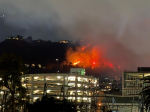
Smoke has once again engulfed the skies over Massachusetts and the Northeast United States, triggering an air quality alert issued by the U.S. Environmental Protection Agency. The smoke,
originating from wildfires in the Canadian province of Quebec, has settled at low altitudes, creating hazy conditions and introducing particulate matter into the air. This poses a significant challenge for individuals with respiratory conditions and affects those engaging in strenuous physical activities.
Interestingly, the smoke is being carried southward into the United States by a stalled weather system that recently brought much-needed rain to Nova Scotia. The system's large, counter-clockwise wind flow has resulted in a prolonged northerly wind pattern in the Northeast U.S., transporting the smoke from Quebec.
This marks the third instance of Canadian wildfire smoke affecting the region in recent weeks. Previously, high-altitude smoke from wildfires in Western Canada and Nova Scotia had impacted the air quality.
The prevailing weather system also influences the local weather conditions, contributing to the formation of clouds and showers. Periods of sun are intermittently observed as dry air interacts with the system, leading to a mix of sunny and cloudy intervals.
Tuesday morning to midday saw a brief sunny period, causing temperatures to rise above 70 degrees Fahrenheit for many areas. However, in the afternoon, showers and thunderstorms are expected to develop, although the likelihood of severe weather is low. Nevertheless, isolated communities may experience locally strong winds due to the abundance of dry air aloft within well-developed downpours.
Severe thunderstorm warnings have been issued for parts of Massachusetts, Connecticut, and Rhode Island, with the potential for strong wind gusts and quarter-size hail. Photo by U.S. Forest Service- Pacific Northwest Region, Wikimedia commons.






































